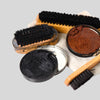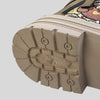Sole Search: A Guide to Shoe Sole Materials
The foundation of any great shoe lies in its sole. More than just the part that hits the ground, the sole material plays a crucial role in determining a shoe's weight, cushioning, durability, and traction, ultimately impacting your comfort and performance. With a plethora of options available, choosing the right sole material can feel overwhelming. Fear not, fellow footwear enthusiasts! This guide will shed light on the most common shoe bottom materials, helping you find your sole mate.
1. Rubber: The Durable Classic
A timeless choice, rubber soles are renowned for their exceptional durability, slip resistance, and tear resistance. These qualities make them a popular choice for sneakers, casual shoes, and even some boots. Additionally, rubber offers decent elasticity, providing a comfortable level of cushioning.
Pros: Durable, slip-resistant, tear-resistant, elastic, cost-effective
Cons: Relatively heavy, limited breathability
Best for: Everyday wear, sports, outdoor activities
2. EVA: Lightweight Cushioning for All-Day Comfort
EVA (ethylene-vinyl acetate) is a lightweight foam material frequently used in midsoles of running shoes and casual footwear. Its defining characteristics are its featherlight feel and plush cushioning, offering exceptional comfort and effectively absorbing impact with every step.
Pros: Lightweight, soft, excellent cushioning, affordable
Cons: Less durable, prone to compression over time
Best for: Running, walking, everyday wear
3. PU: Responsive Support for High-Impact Activities
PU (polyurethane), a polymer material, is often found in midsoles of basketball shoes and training footwear. PU soles excel in energy return and support, providing stability and protection during dynamic movements while effectively mitigating impact forces.
Pros: Excellent energy return, supportive, more durable than EVA
Cons: Relatively heavy, limited breathability, prone to yellowing over time
Best for: Basketball, tennis, gym training
4. MD: The Enhanced EVA for Balanced Performance
MD (PHYLON), a modified EVA compound, is created through a secondary foaming process. It inherits EVA's lightweight and cushioned nature while boasting improved durability and responsiveness, offering a more balanced performance profile.
Pros: Lightweight, soft, excellent cushioning, good energy return, more durable than EVA
Cons: Slightly more expensive than EVA
Best for: Running, walking, everyday wear
5. TPR: The Eco-Conscious and Budget-Friendly Option
TPR (thermoplastic rubber) combines the properties of rubber with the processing advantages of plastic. Commonly used in casual shoes and sandals, TPR soles offer commendable durability, slip resistance, and elasticity, all at an attractive price point. Additionally, TPR is an environmentally friendly material.
Pros: Durable, slip-resistant, elastic, affordable, eco-friendly
Cons: Relatively heavy, limited breathability
Best for: Everyday wear, casual outings
6. Leather: The Epitome of Elegance and Breathability
Leather soles are synonymous with luxury and sophistication, often gracing high-end dress shoes and boots. Their exceptional breathability ensures a comfortable wearing experience, allowing your feet to stay cool and dry. However, leather soles require more care and are less durable and slip-resistant compared to other materials.
Pros: Luxurious, breathable, comfortable
Cons: Less durable, less slip-resistant, expensive, requires meticulous care
Best for: Formal occasions, business casual settings
Finding Your Sole Mate: It's All About You!
Choosing the right sole material boils down to understanding your needs and intended use:
-
Active Individuals: Prioritize cushioning and energy return with EVA, MD, or PU soles.
-
Everyday Commuters: Opt for durability and slip resistance with rubber or TPR soles.
-
Comfort Seekers: Embrace the plush feel of EVA, MD, or leather soles.
-
Style Enthusiasts: Elevate your look with the timeless elegance of leather soles.
Step into Comfort and Style
Remember, the "best" sole material is subjective and depends on your individual preferences and requirements. By understanding the unique characteristics of each material, you can make informed decisions and find the perfect shoes to support your every step in comfort and style. Happy shoe shopping!


